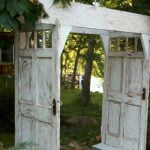101 ideas for small gardens are waiting to be discovered. Small gardens may lack the space of their larger counterparts, but they certainly don’t lack in beauty and potential.
In this article, we’ll explore a plethora of ideas for maximizing the potential of small gardens, from creative planting and functional design to budget-friendly options and more. Whether you have a tiny backyard, patio, or balcony, these ideas will help you make the most of your small garden space.
When it comes to small gardens, creativity is key. With the right techniques and strategies, you can transform even the tiniest outdoor space into a lush and vibrant oasis.
From vertical gardening to container gardening, there are numerous ways to maximize space and create a stunning garden that feels just as expansive as a larger one. And with the right choice of plants and design elements, you can enhance the beauty of your small garden while also making it functional for relaxation, dining, and entertainment.
In this article, we’ll delve into the various aspects of designing and cultivating small gardens, offering tips and inspiration for every step of the process. Whether you’re looking for low-maintenance solutions or affordable DIY projects, there’s something here for every aspiring gardener with limited space. So let’s begin our exploration of the beauty of small gardens and uncover 101 ideas to help you create your own little slice of paradise.
Maximizing Space
When it comes to small gardens, space is often the biggest limitation. However, there are plenty of creative ways to maximize the available space and make the most out of a compact outdoor area. One popular solution is vertical gardening, which involves growing plants upwards instead of outwards. This can be achieved by using trellises, wall-mounted planters, or hanging baskets. Here are some ideas for vertical gardening:
- Install a vertical garden on a fence or wall using pocket planters
- Use a ladder-style plant stand to create multiple levels for planting
- Hang a shoe organizer on a wall and fill each pocket with soil for planting herbs or small flowers
Another effective way to maximize space in small gardens is through container gardening. This method allows you to grow plants in a variety of different containers, such as pots, buckets, or even repurposed items like wheelbarrows or old furniture. Here are some creative container gardening ideas:
- Create a herb garden in a set of tiered terracotta pots
- Plant succulents in vintage teacups or mugs for a whimsical touch
- Repurpose an old wooden crate as a planter for colorful annual flowers
By utilizing these vertical and container gardening ideas, even the smallest of spaces can be transformed into lush and vibrant garden areas.
Incorporating these techniques into the design of a small garden can help make the most out of limited space while still allowing for an abundance of greenery and blooms. Whether it’s creating an eye-catching living wall with cascading plants or crafting an eclectic collection of container gardens, there are countless options to explore when it comes to maximizing space in small gardens.
Creative Planting
When it comes to small gardens, choosing the right plants is crucial in order to maximize the limited space available. The key is to select plants that will thrive in a confined environment while also adding beauty and interest to your garden. One idea for small gardens is to focus on versatile plants that can serve multiple purposes, such as herbs that can be used for both cooking and adding greenery to the space.
Another great idea for small gardens is to incorporate vertical gardening techniques by choosing climbing or trailing plants. This not only adds visual interest but also allows you to make the most of vertical space, freeing up valuable ground area for other elements such as seating or dining areas.
Additionally, container gardening is a fantastic option for small gardens, as it allows for flexibility and mobility. You can easily move containers around to create different arrangements and make the most of sunlight and shade throughout the day.
In terms of aesthetics, consider mixing different plant heights, textures, and colors to create depth and visual appeal in a small garden. Incorporating a variety of plant sizes and shapes can make your garden feel larger than it actually is.
It’s also important to choose plants that are low-maintenance and well-suited to your climate and soil conditions since small spaces can quickly become overwhelmed if plants require constant care. By carefully selecting the right plants for your small garden, you can create a lush and inviting outdoor oasis regardless of its size.
| Small Garden Planting Ideas | Benefits |
|---|---|
| Versatile plants (herbs) | Serve multiple purposes |
| Vertical gardening techniques (climbing/trailing plants) | Maximize vertical space |
| Container gardening | Flexibility and mobility |
Functional Design
Incorporating seating, dining, and entertainment areas into a small garden can be a challenging task, but with the right ideas and creativity, it is definitely achievable. Here are some tips and suggestions for maximizing functionality in a small outdoor space:
- Choose multi-functional furniture: Opt for pieces that can serve dual purposes, such as a bench with built-in storage or a coffee table that doubles as a dining table.
- Create designated zones: Divide your garden into different areas for seating, dining, and entertainment to make the most of the available space.
- Utilize vertical space: Hang plants and decor on walls or fences to free up floor space for seating or dining areas.
When it comes to incorporating seating, consider using compact chairs or benches that can be easily tucked away when not in use. For dining areas, bistro sets or foldable tables and chairs are ideal choices for small gardens. Additionally, creating an entertainment area can be as simple as adding a small fire pit, outdoor speakers, or string lights to enhance the ambiance.
Ultimately, functional design in small gardens is all about maximizing every inch of space to create comfortable and inviting seating, dining, and entertainment areas. With careful planning and strategic placement of furniture and decor items, even the tiniest of gardens can become a versatile outdoor oasis.
Low-Maintenance Solutions
When it comes to small gardens, low-maintenance solutions are key to ensuring that your outdoor space remains beautiful without too much effort. In this section, we will explore some suggestions for easy care plants and sustainable practices that are perfect for small gardens.
Choosing Easy Care Plants
When selecting plants for your small garden, opt for varieties that require minimal maintenance. This includes choosing native plants that are well-suited to your local climate and soil conditions. Additionally, look for plants with a long blooming season or those that have interesting foliage to add visual interest to your garden throughout the year. Some examples of easy care plants include lavender, succulents, ornamental grasses, and butterfly bushes.
Implementing Sustainable Practices
Incorporating sustainable practices into your small garden not only reduces maintenance but also benefits the environment. Consider installing a rain barrel to collect rainwater for watering your plants, which reduces your reliance on traditional water sources. Additionally, practicing composting can provide nutrient-rich soil for your garden without the need for chemical fertilizers. Embracing natural pest control methods such as introducing beneficial insects can also contribute to a healthier and more low-maintenance garden.
Smart Design Choices
Aside from plant selection and sustainable practices, making smart design choices can also contribute to a low-maintenance small garden. Utilize mulch in your garden beds to reduce weed growth and retain moisture in the soil. Incorporate hardscaping elements such as gravel pathways or raised beds to minimize the need for regular upkeep. By incorporating these simple design choices and practices, you can enjoy a beautiful and low-maintenance small garden with ease.
With these suggestions for easy care plants and sustainable practices, you can create a stunning and manageable garden that thrives in a small space. Whether you’re a busy urbanite or simply prefer spending less time on gardening chores, implementing these ideas will help you achieve a thriving outdoor oasis without all the fuss.
Transforming Small Spaces
One of the key challenges for small garden owners is how to make the space feel bigger than it actually is. There are several strategies you can use to create illusions of depth and space in a small garden.
First, consider using diagonal lines in your garden design. Diagonal lines draw the eye across the garden, making it appear larger than it really is. You can achieve this by adding pathways or plant beds that run diagonally across your garden rather than in straight lines.
Another way to make a small garden feel more spacious is to incorporate layers into your design. By creating different levels within the garden, such as raised plant beds or sunken seating areas, you can add visual interest and depth to the space. This also creates the illusion of separate “rooms” within the garden, making it feel larger and more dynamic.
Finally, think about incorporating reflective surfaces into your small garden. Mirrors, glass ornaments, or metallic planters can all help bounce light around the space and create the illusion of depth. Just be strategic about where you place these reflective elements to avoid overwhelming the space with too much glare.
With these tips in mind, even the smallest of gardens can feel like a spacious outdoor oasis.
| Small Garden Illusion Strategy | Description |
|---|---|
| Diagonal Lines | Incorporate pathways or plant beds that run diagonally to create an illusion of depth. |
| Layered Design | Create different levels within the garden with raised plant beds or sunken seating areas to add visual interest and depth. |
| Reflective Surfaces | Add mirrors, glass ornaments, or metallic planters to bounce light around and create a sense of depth. |
Theme and Style
Designing a small garden with a specific theme or aesthetic can elevate the look and feel of the space, making it more appealing and cohesive. Whether you prefer a contemporary, cottage, tropical, or minimalist style, there are numerous ideas to consider when choosing a theme for your small garden.
Contemporary Elegance
For those who gravitate towards clean lines and modern design, a contemporary garden may be the perfect fit. Incorporate sleek furniture, geometric planters, and minimalistic outdoor dcor to create a sophisticated and uncluttered look. Consider using bold colors and experimenting with different textures to add visual interest to the space.
Cottage Charm
If you prefer a more traditional and cozy atmosphere, opting for a cottage-style garden could be the ideal choice. Fill your garden with an abundance of colorful flowers, whimsical accessories, and rustic furnishings to evoke a sense of nostalgia and warmth. Consider incorporating vintage finds and quaint pathways to enhance the charming aesthetic.
Tropical Oasis
For those seeking a vacation-inspired retreat right in their backyard, designing a tropical-themed garden can provide an escape from reality. Opt for lush greenery, exotic plants, and vibrant blooms to create an immersive tropical experience. Include elements such as hammocks or lounge chairs to encourage relaxation and leisure in the space.
By identifying the theme or aesthetic that resonates with your personal style preferences, you can transform your small garden into a unique and visually captivating outdoor oasis that reflects your individuality.
Budget-Friendly Options
In conclusion, small gardens can be just as beautiful and functional as larger ones with the right planning and creativity. By maximizing space with vertical gardening and container gardening, choosing the right plants for small spaces, incorporating functional design elements, and implementing low-maintenance solutions, even the tiniest of gardens can flourish.
With the right theme and style, a small garden can become a personal oasis or an inviting entertainment area. And with budget-friendly options such as DIY projects and affordable garden dcor, creating a stunning small garden is within reach for everyone.
The 101 ideas for small gardens presented in this article offer a wealth of inspiration and practical advice for those looking to make the most of their limited outdoor space. Whether it’s transforming small spaces to create illusions of depth and space or designing a small garden with a specific theme or aesthetic in mind, there are countless ways to turn a compact outdoor area into a stunning green retreat.
Frequently Asked Questions
How Do You Plan a Garden for Beginners?
Planning a garden for beginners involves several key steps. Start by considering the location, size, and purpose of your garden.
Research the types of plants that will thrive in your climate and soil type, and create a layout that takes into account the needs of each plant. It’s also important to plan for maintenance, including watering, weeding, and pest control.
How Do You Make a Plan for a Small Garden?
When making a plan for a small garden, it’s important to maximize the use of space. Consider using vertical elements like trellises or hanging pots to make the most of limited ground space.
Choose plants that are well-suited for small spaces, such as compact varieties or those that can be trained to grow upward instead of outward. Also, consider incorporating multi-functional elements like seating areas or edible plants.
How Do You Build a Small Garden Space?
Building a small garden space begins with preparing the ground properly. Clear any debris and weeds, and improve the soil by adding compost or other organic matter.
Determine how you want to define the borders of your garden – whether with raised beds, edging materials, or simply planting directly into the ground. Then carefully plant your chosen plants while taking their growth habits and spacing requirements into consideration.

Welcome to my gardening blog! I am passionate about plants and enjoy sharing my knowledge and experiences with others. In this blog, I will write about everything related to gardening, from tips on how to get started to updates on my own garden projects.





